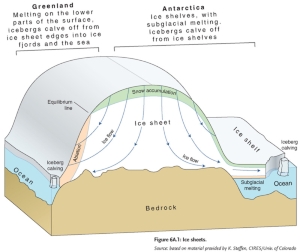Where ice melts without warmthWe sit hunched around yr.no intensely scrutinising the weather conditions in the Bay of Whales, on the Axel Heiberg glacier and at the South Pole. “How can scientists worry about ice melting in Antarctica?” asks Vegard. “The temperature is -30°C and that’s what we get when it’s springtime in Antarctica!”
“SE gale with thick drift during the night, continuing all day. Have been forced to stay put.”– Amundsen on this day 100 years ago (Read more …) 
Antarctica is renowned for its cold. The mountains in the middle of Antarctica are buried under several kilometres of ice that never melts. The highest temperature ever recorded at the South Pole is -13.6°C and the yearly average is a frigid -50°C. So how could anyone be worried that a few degrees of warming could make the ice melt? The answer lies at the coast. Antarctica’s ice creeps slowly towards the north, but speeds up in the steeper terrain farther north. When it reaches the sea, the ice spreads out across hundreds of kilometres, lying atop the water. The Antarctic continent is surrounded by floating glaciers several hundred metres thick. In this way it differs from Greenland, where the ice flows out into fjords, just like the Svalbard glaciers we know so well (see the figure). The climate at the coast – especially along the Antarctic Peninsula – is much milder than in the continent’s altitudinous inland. Temperatures around freezing are relatively common in the summer months. In addition, these more northerly areas have seen a particularly strong warming trend in the past decades. This has led to increased calving from the floating ice. Several ice shelves have collapsed and disappeared altogether. When they are gone, the ice lying over solid ground flows more quickly. The damming effect of the ice shelf has been eliminated. This leads to a domino effect. Melting at the coast triggers accelerated outflow of ice from the constantly sub-zero areas farther inland. Faster ice flow leads to more calving from the ice shelves. The resulting icebergs drift northward and melt, ultimately influencing sea level. This explains the apparent physical impossibility: ice can melt without warmth. Did you know that two Sami men participated in the first overwintering on the Antarctic continent?
The two Sami went along to care for the dogs on an English expedition that overwintered in Antarctica from 1898 to 1900. |
South Pole 1911–2011 is an informational outreach project run by the Norwegian Polar Institute
Contact person:


